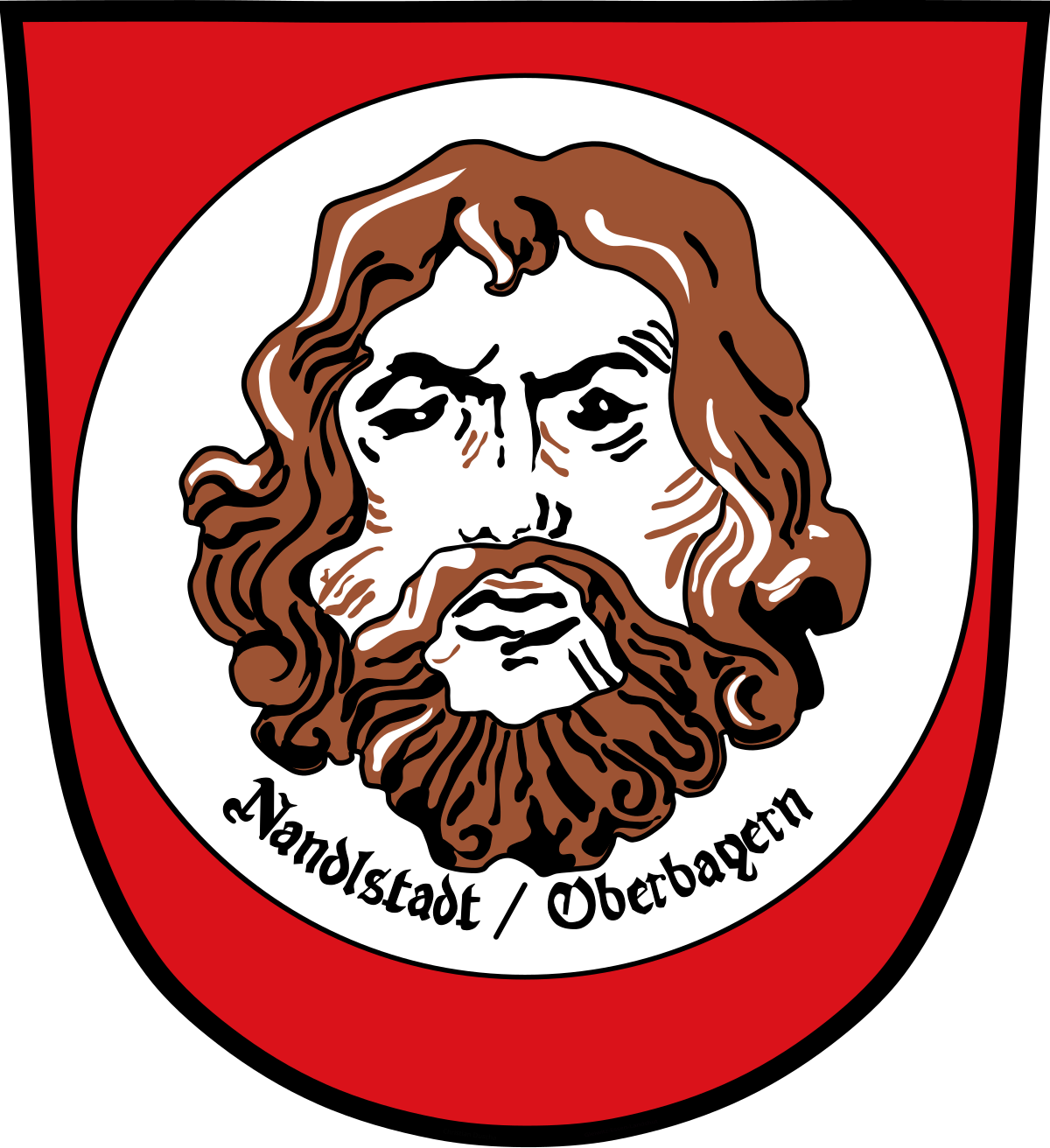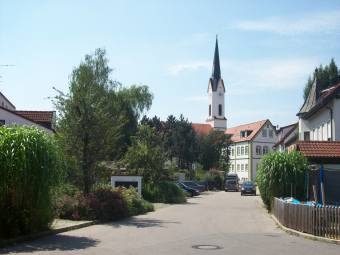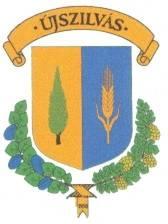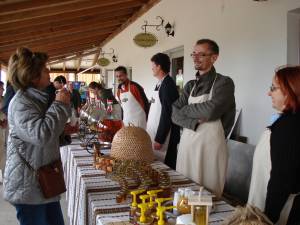
Inmitten von bewaldeten Hügeln, Äckern und Wiesen und den charakteristischen Hopfengärten der Hallertau liegt im nördlichen Landkreis Freising auf einer Seehöhe von 480 m der Markt Nandlstadt.
Nur 20 km nach Süden – und man ist in der alten Bischofsstadt Freising. Zum internationalen Flughafen Franz-Joseph Strauß sind es 28 km. München liegt in der gleichen Richtung 50 km entfernt.
In 35 km erreichen Sie Landshut (östliche Richtung), nur 15 km sind es bis zu der kleinen Stadt Moosburg.
80 km nördlich liegt die alte Bischofsstadt Regensburg (über die A 93), und im Nordwesten erreichen Sie über die A 9 Ingolstadt. Wenn Sie beschaulichere Städtchen bevorzugen: Nach Mainburg sind es 15 km

Einwohnerzahl: 5.697 (Stand 30.06.2023)
Höhenlage: 480 m über dem Meeresspiegel
Gemeindegebiet: 3.431 ha
Länge der Gemeindestraßen: 67,145 km
davon ausgebaut: 65,308 km

Wappenbeschreibung:
In rot auf einer runden silbernen Schüssel das bärtige Haupt des hl. Johannes des Täufers
Das Wappen ist seit der sogenannten Brandurkunde von 1374, an die es erstmals gehängt wurde, überliefert.
Die Umschrift lautet: S. (Sigillum) civium Nandolzstat. Der Heilige ist der Patron der Pfarrkirche.
Die Gestaltung des Johanneshauptes und der Schüssel wurde in zahlreichen Marktsiegeln bis heute und im Schrifttum häufig wechselnd wiedergegeben.
(Auszug aus der Marktchronik)
Bereits 1534 wird allerdings der Hl. Martin als Kirchenpatron genannt, wie die Biographie von Pfarrer Philipp Leibig berichtet. Dieser Heilige ist bis heute der Schutzheilige der Nandlstädter Kirche.
Noch ein kleines geschichtliches Detail:
Anfang des 19. Jahrhunderts gefiel den Nandlstädtern ihr Wappen nicht mehr, weil sie in dem abgeschlagenen Haupt auf der Schüssel eine Anspielung auf die früheren Hinrichtungen im Ort sahen. Sie ließen sich daher vom König auch ein neues Wappen, einen Kranz im weiß-blauen Feld, bestätigen. Das alte Wappen setzte sich aber bald wieder durch.

Ein geschichtlicher Streifzug durch Nandlstadt
Hall-hart-aue, von dem wohl ursprünglich der Name Hallertau kommt, bezeichnete wahrscheinlich eine hügelige Wald- und Wiesenlandschaft. Und mitten in dieser sanften Hügellandschaft liegt der Markt Nandlstadt.
Und woher kommt der Ortsname? Zwei mögliche Deutungen gibt es: Einmal könnte Nandlstadt von einem Ortsgründer namens Nandolf herstammen. Es ist aber auch möglich, dass die Talmulde, in der Nandlstadt liegt, einst eine germanische Kultstätte war. In der keltischen Sprache bedeutet naomh „heilig“. So könnte es durchaus auch sein, dass Nandlstadt, wie viele Orte in Bayern, keltischen Ursprung hat.

Nandlstadt ist eine attraktive Wohngemeinde und besitzt seit 1. Mai 1979 den Status eines Kleinzentrums. Durch die konsequente Ausweisung von Baugebieten seit der Mitte der 60er Jahre des 20. Jahrhunderts und den stetigen Zuzug erhöhte sich die Bevölkerung ständig. Heute leben ca. 5.600 Bürger im Gemeindegebiet.
Der Ort hat einen hohen Wohn- und Freizeitwert. Malerisch ist die Marktstraße, Nandlstadts gute Stube, mit behäbigen Bürgerhäusern aus dem Ende des 19. und dem Anfang des 20. Jahrhunderts, mit der Pfarrkirche St. Martin und dem markanten neugotischen Rathaus mit seinem charakteristischen Türmchen.


Den ersten offiziellen Kontakt zwischen der Gemeinde Újszilvás und Nandlstadt gabe es im Jahr 2005, als sich ein Bus voller Ungarn zu einem Besuch in Nandlstdt aufmachte.
Im Jahr 2007 gründeten die Nandlstädter in Bayern und die Újszilváser in Ungarn dann eine Gemeinde-Partnerschaft. Beim Ungarischen Abend im Rahmen des 50. Nandlstädter Hopfenfestes wurde ein Partnerschaftsvertrag zwischen den beiden Gemeinden unterzeichnet.
Freundschaft ist nicht nur ein köstliches Geschenk, sondern auch eine dauerhafte Aufgabe!
So lautete das Motto des Vertrages. Gleichberechtigung, Toleranz, Ausgewogenheit, gegenseitige Achtung und Wertschätzung sollen die Grundsätze dieser Partnerschaft sein.
Vom 12. bis 14. Oktober 2007 wurde die Partnerschaft dann in Újszilvás nochmal besiegelt. Die gastfreundlichen Ungarn hatten die Hallertauer dazu eingeladen.
Im August 2008 besuchte eine Abordnung der Nandlstädter erneut die Partnergemeinde und beim Weihnachtsmarkt im gleichen Jahr verkauften die Ungarn zum ersten Mal regionale Produkte aus ihrer Heimat.
Mittlerweile herrscht reger Austausch – besonders Kinder und Jugendliche haben schon mehrere Male eine Ferienwoche in Újszilvás verbracht – und auch ungarische Jugendliche waren schon öfter in Nandlstadt zu Besuch.
Újszilvas ist eine Gemeinde mit ca. 3.500 Bürgern und liegt 780 km entfernt von Nandlstadt und ca. 70 km südöstlich von Budapest. Einige aufstrebende Betriebe sorgen für reges wirtschaftliches Leben. In der Nähe kann der bekannte Kincem-Park mit dem Attila-Hügel besucht werden. Außerdem gibt es ein Lippizaner-Gestüt. Der Bürgermeister heißt Csaba Petranyi.
Marktgemeinde Nandlstadt
We firmly believe that the internet should be available and accessible to anyone, and are committed to providing a website that is accessible to the widest possible audience, regardless of circumstance and ability.
To fulfill this, we aim to adhere as strictly as possible to the World Wide Web Consortium’s (W3C) Web Content Accessibility Guidelines 2.1 (WCAG 2.1) at the AA level. These guidelines explain how to make web content accessible to people with a wide array of disabilities. Complying with those guidelines helps us ensure that the website is accessible to all people: blind people, people with motor impairments, visual impairment, cognitive disabilities, and more.
This website utilizes various technologies that are meant to make it as accessible as possible at all times. We utilize an accessibility interface that allows persons with specific disabilities to adjust the website’s UI (user interface) and design it to their personal needs.
Additionally, the website utilizes an AI-based application that runs in the background and optimizes its accessibility level constantly. This application remediates the website’s HTML, adapts Its functionality and behavior for screen-readers used by the blind users, and for keyboard functions used by individuals with motor impairments.
If you’ve found a malfunction or have ideas for improvement, we’ll be happy to hear from you. You can reach out to the website’s operators by using the following email
Our website implements the ARIA attributes (Accessible Rich Internet Applications) technique, alongside various different behavioral changes, to ensure blind users visiting with screen-readers are able to read, comprehend, and enjoy the website’s functions. As soon as a user with a screen-reader enters your site, they immediately receive a prompt to enter the Screen-Reader Profile so they can browse and operate your site effectively. Here’s how our website covers some of the most important screen-reader requirements, alongside console screenshots of code examples:
Screen-reader optimization: we run a background process that learns the website’s components from top to bottom, to ensure ongoing compliance even when updating the website. In this process, we provide screen-readers with meaningful data using the ARIA set of attributes. For example, we provide accurate form labels; descriptions for actionable icons (social media icons, search icons, cart icons, etc.); validation guidance for form inputs; element roles such as buttons, menus, modal dialogues (popups), and others. Additionally, the background process scans all the website’s images and provides an accurate and meaningful image-object-recognition-based description as an ALT (alternate text) tag for images that are not described. It will also extract texts that are embedded within the image, using an OCR (optical character recognition) technology. To turn on screen-reader adjustments at any time, users need only to press the Alt+1 keyboard combination. Screen-reader users also get automatic announcements to turn the Screen-reader mode on as soon as they enter the website.
These adjustments are compatible with all popular screen readers, including JAWS and NVDA.
Keyboard navigation optimization: The background process also adjusts the website’s HTML, and adds various behaviors using JavaScript code to make the website operable by the keyboard. This includes the ability to navigate the website using the Tab and Shift+Tab keys, operate dropdowns with the arrow keys, close them with Esc, trigger buttons and links using the Enter key, navigate between radio and checkbox elements using the arrow keys, and fill them in with the Spacebar or Enter key.Additionally, keyboard users will find quick-navigation and content-skip menus, available at any time by clicking Alt+1, or as the first elements of the site while navigating with the keyboard. The background process also handles triggered popups by moving the keyboard focus towards them as soon as they appear, and not allow the focus drift outside it.
Users can also use shortcuts such as “M” (menus), “H” (headings), “F” (forms), “B” (buttons), and “G” (graphics) to jump to specific elements.
We aim to support the widest array of browsers and assistive technologies as possible, so our users can choose the best fitting tools for them, with as few limitations as possible. Therefore, we have worked very hard to be able to support all major systems that comprise over 95% of the user market share including Google Chrome, Mozilla Firefox, Apple Safari, Opera and Microsoft Edge, JAWS and NVDA (screen readers).
Despite our very best efforts to allow anybody to adjust the website to their needs. There may still be pages or sections that are not fully accessible, are in the process of becoming accessible, or are lacking an adequate technological solution to make them accessible. Still, we are continually improving our accessibility, adding, updating and improving its options and features, and developing and adopting new technologies. All this is meant to reach the optimal level of accessibility, following technological advancements. For any assistance, please reach out to